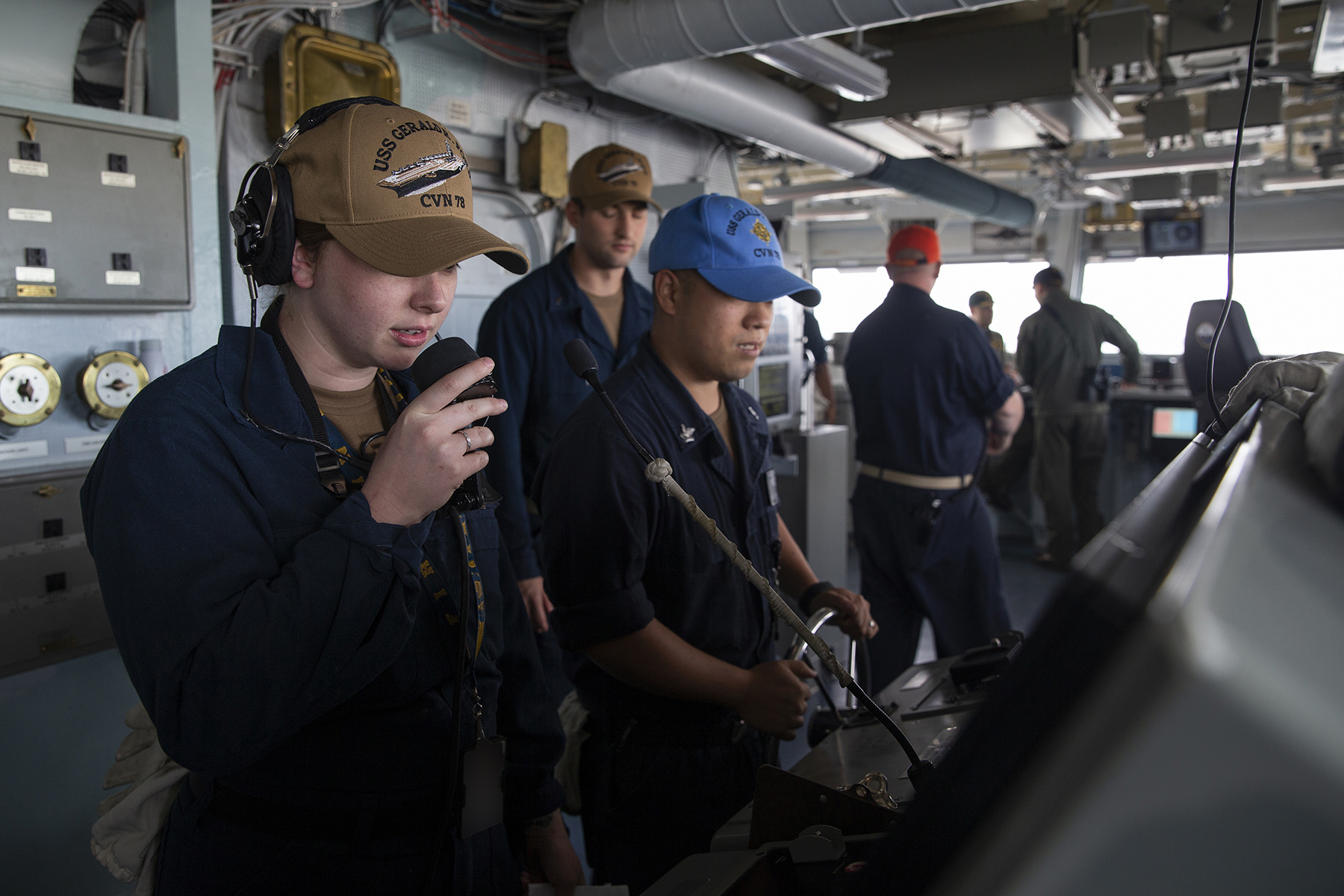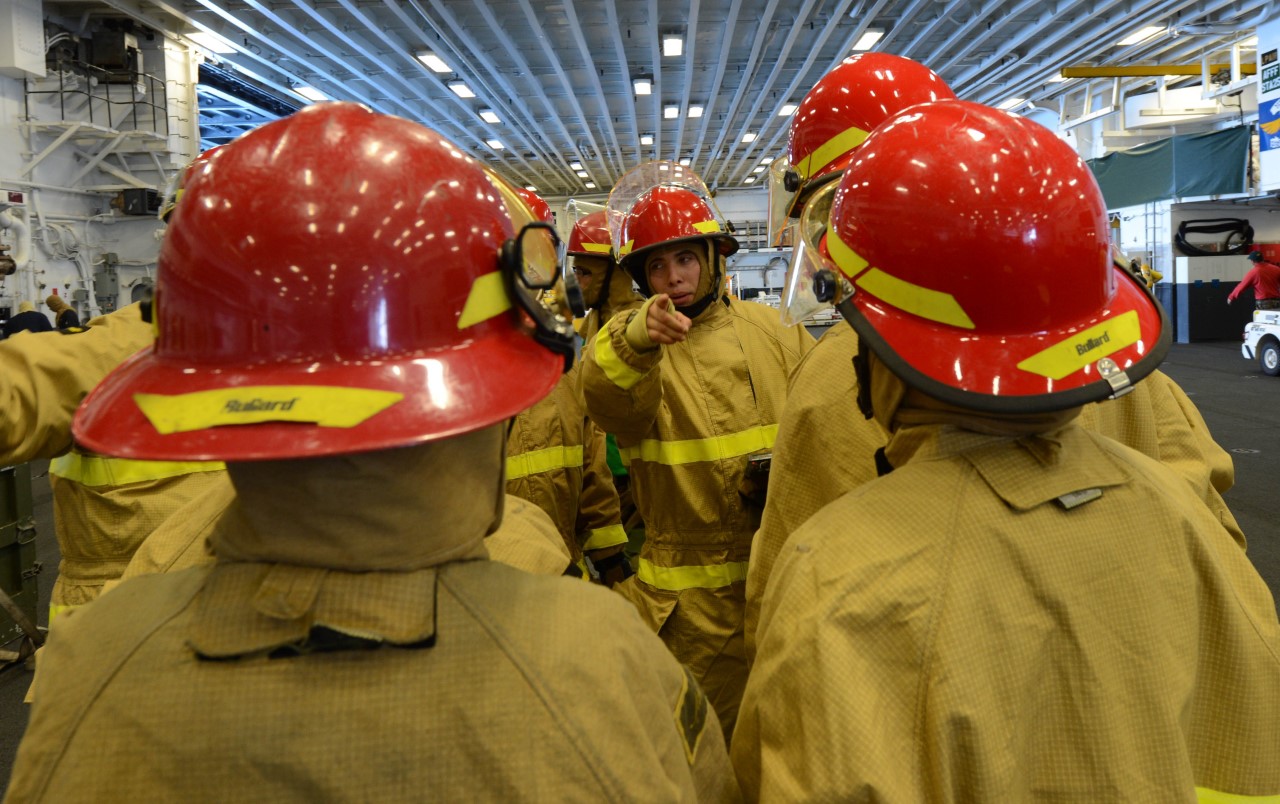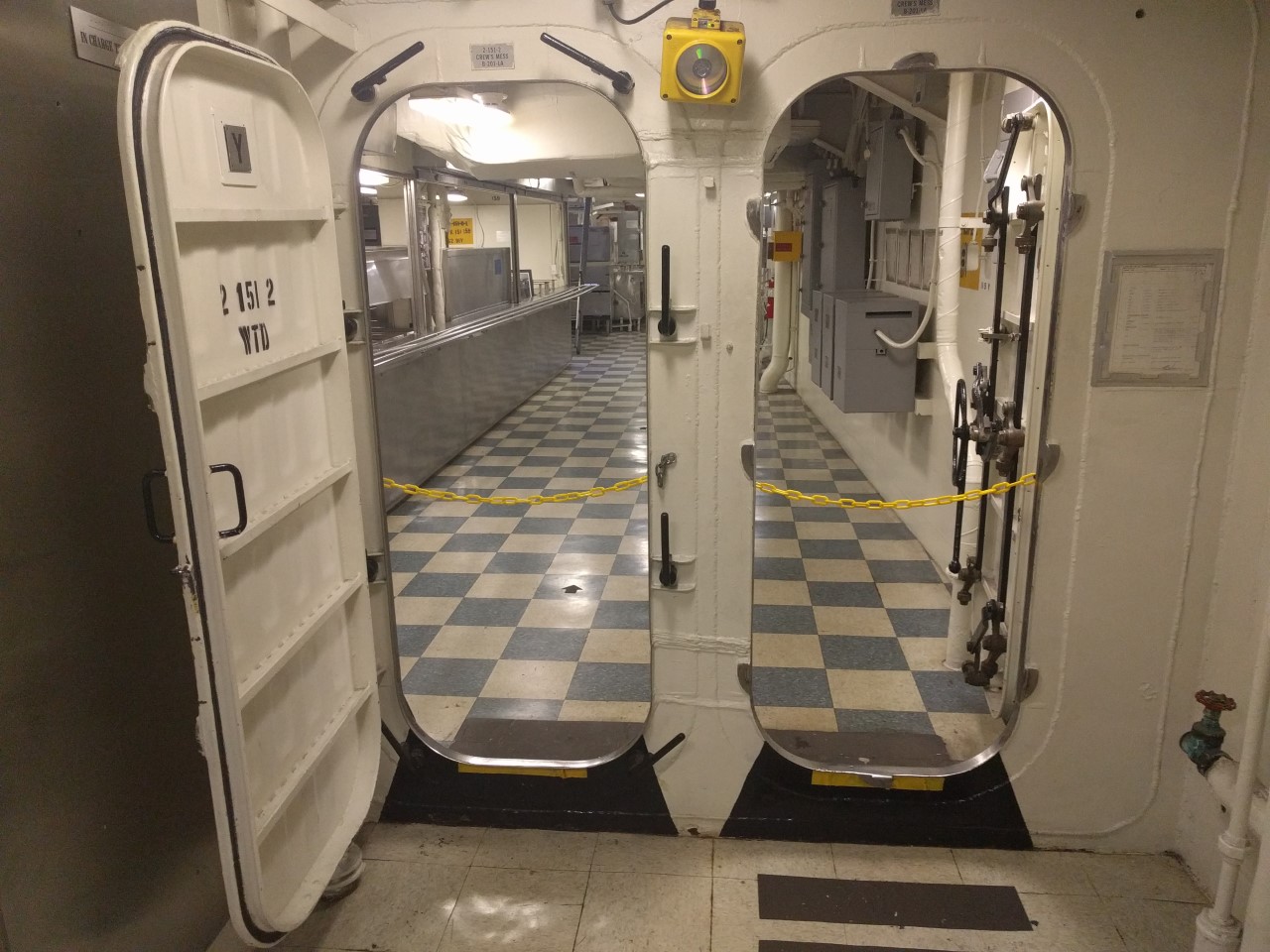While I've previously written about the process by which ship are kept running during normal operations, warships in particular often operate in ways that are far from normal. This involves a set of what are known as "Conditions", which apply to both the crew and the ship itself, and which are worth looking into.1

Sailors man the bridge of Gerald R. Ford during a General Quarters drill
The most famous of these is General Quarters, more popularly known as Battle Stations (or Action Stations for the Brits) and also called Condition I. As the name implies, this is what the ship does when action is imminent, or in any other circumstances when the ship needs to be ready to deal with problems on a moment's notice. This is typically announced with a klaxon and a call of "General Quarters, General Quarters. All hands man your battle stations. Forward and up to starboard, down and aft to port. Set material condition 'Zebra' throughout the ship." Every member of the crew is to drop whatever they're doing2 and head for their assigned station, following the "forward and up to starboard, down and aft to port" directions to avoid major traffic jams.
Ships routinely conduct drills to make sure the crew is able to reach GQ quickly, and every member has a specific job to do. Many of these are related to their day-to-day functions, ranging from manning the guns to operating radars and keeping the engines running. But what about support personnel, the cooks and clerks whose roles are not required in action? There are also many jobs that can be done by semi-skilled personnel. For instance, much of the ship's communications infrastructure relies on sound-powered phones, which will keep working even if the power goes out, but require a talker at the other end to relay messages. In the past, semi-skilled personnel often provided much of the manual labor to pass ammunition and service manpower-intensive systems. Others are assigned as lookouts or to damage-control parties, ready in case flood or fire must be fought.

Sailors prepare to fight fires onboard Bon Homme Richard
To aid in such fights, going to General Quarters also involves locking down the ship. The US Navy uses three "material conditions", which dictate which doors and other fittings can be opened, balancing ease of use with the need to protect the ship. Each of these objects is labeled with an X, Y or Z, as appropriate to the condition it has to be closed under. Condition X-Ray is set during the day while in port or at anchor, and involves the least restrictions. Condition Yoke is typical while a ship is at sea, or at night while in port, while Condition Zebra is used during GQ, or at other times when flooding is a serious concern.3 Any violation of the material condition requires permission and has to be logged. Some fittings are marked with a W ("William"), and these are things like seawater intakes that should always be left open, except during very specific cases. A Ws few have circles around them, which indicates that they should be closed in case of chemical or nuclear attack.
Circles and other modifications are also used on the base letters. Circle X-Ray and Circle Yoke represent fittings that can be opened without permission during GQ when something (people, ammunition, etc) need to go through them, so long as they're closed afterwards. Dog Zebra, represented by a D around the Z, is used for fittings that need to be closed to prevent stray light from escaping while underway at night. To aid this, some exterior doors are fitted with a second, inner door, and the area around them is painted black. Circle Zebra is used when the ship is going to be at GQ for long periods and action isn't imminent, and allows sailors to access the heads, prepare and distribute battle rations and get some fresh air. However, anything opened under Circle Zebra must be guarded for immediate closure.

A pair of doors leading into the mess deck on Iowa. The door on the left is marked with a Y, while the one on the right is Z. Note that the left door has individual dogs, while the right one is quick-acting, with all of the dogs linked to make it faster to open and close in an emergency.
Circle Zebra broadly corresponds with Condition IE, which is the variation on Condition I that allows the crew to eat and relieve themselves. A slightly more relaxed condition is Condition II, which tailors the ship’s readiness to fight specific warfare areas (eg IIAW for air threats, IIAS for submarine threats, or Striker for launching TLAMs). All of these will involve slightly different personnel in different places than a generic Condition I, and not every ship is likely to use all of them. Theoretically, a ship should be able to stay in a Condition II posture for a single warfare area for extended periods of time; personnel shortfalls and the grind of trying to maintain normal operations mean that this isn’t true, but you can definitely operate more normally than at Condition I. Historically, Condition II also referred to port-and-starboard steaming, with half the crew on duty at a time. Condition III is standard in wartime, with about a third of the crew on watch, while Condition IV is normal peacetime cruising. Conditions V and VI are used in port, with V having enough personnel to get underway in an emergency, and VI involving just enough crew to fight minor fires or flooding.
In addition to conditions of readiness, there are other operations that require specialized teams to be used so that the ship can safely and effectively perform them. These teams are usually called “details” (Flight Quarters is an exception to the naming convention), and often work in combination. For example, if you are sailing too close to land or shallow water, you would need to station the Navigation Detail. If you are planning to pull into port, you would need the Sea and Anchor Detail to be stood up. And since port=land, you would need both the details. If fog is out, it’s time to station the Low Visibility Detail. If you are expecting to launch or land aircraft, you’ll need to set Flight Quarters.
One distinction worth noting on the difference between conditions of readiness and special details is that details are in addition to normal conditions of readiness; thus, you can be at Condition II or Condition III and have to do flight quarters while maintaining all the personnel on watch as those conditions require (in GQ, either you have all the people you need already built into the GQ watchbill-this is how the Navigation Detail would work-or you can’t do those extra details without relaxing from GQ). Thus, you will not be able to maintain special details for extended periods of time, and planning for them becomes an important aspect of tactical operations.
Theoretically, every sailor has a position in every watchbill for every condition of readiness and most have a position in the various details; junior officers are known to keep a copy of a document called the Watch, Quarter, and Station Bill that notes the work location of all his or her sailors at any time (along with where they sleep).4 Sometimes a sailor will get lucky and slip through and not have a watch station, and then he or she gets a happy (and probably short) respite.
1 Thanks to Blackshoe for helping to write this and providing details that don't make their way into books. ⇑
2 At least so long as they're not doing something critical that someone else is coming to take over, that is. ⇑
3 Blackshoe: I am pretty sure that these are the last things in the DoD to use the Joint Army-Navy phonetic system of World War 2 fame. ⇑

Comments
So General Quarters is what they are talking about, when you see junior officers in period pieces shout "Beat to quarters!"?
"Sailors prepare to fight fires onboard Bon Homme Richard"
That made me chuckle (mostly because I am not a US taxpayer).
@ike
The two are related. The language they used in the age of sail was somewhat different from what they do now, so I wouldn't call them exactly equivalent, but modern GQ evolved from the quarters of that era.
@Emilo
I was looking for pictures of DC practice, and for some reason DVIDS showed me BHR and very few other ships, so I decided to make the joke.
Speaking of BHR - mid refit it was probably condition VI, right?
I'm not sure that ships in the yard are even on the Condition chart, actually. But she was definitely not higher than Condition VI, and might well have not had even that much crew onboard.
I was right; port-and-starboard made the next installment : ) (I don't recall if the literal word "conditions" was used in Red Storm Rising, but off-hand I can't recall if anyone said "battle stations" either.)
I should either buy a copy on Kindle or read it if I have it already
I guess this has been an evolutionary process, adding stuff over time to deal with new stuff (like NBC threats) or address failures?
Was most of it in place before WWII, from WWI experience?
It's interesting that Iowa's mess deck has a door that would have only been opened while in port, if I'm understanding the system. Kinda doesn't seem worth including.
I believe the system has changed some since WWII. My 1943 Bluejacket's Manual suggests that instead of X, Y and Z, they had doors labeled "OPEN IN ACTION" and "CLOSED IN ACTION", which is slightly clumsy. Nothing about NBC, which was a significant concern right after WWI, but diminished in the 1930s.
As for Iowa, I'd guess that the standards probably changed over time. Or they thought they'd need the extra door for moving stuff around in port (supplies spring to mind) and wouldn't generally at sea.
David's comment makes me realize I didn't even discuss in port conditions of readiness; the short answer is the numbered conditons (eg Condition IV) here only apply at sea and in port has a very different set up. There are no tactical conditions of readiness, just requirements for extra details that drive your watchbill (and the DC conditions of readiness, which don't change).
Ships in a yard period are in a lower condition of DC readiness. Theoretically, they are supposed to be able to be maintained at Yoke (or, better said, the deviations that keep it from being at Yoke are supposed to be noted, and preparations to set fire/flooding boundaries in a hurry, which obviously didn't happen for BHR).
IIRC there once actually was a "Condition V" for in port, but by my time, it was something you only saw on old instructions that hadn't been updated in a long time.
Interesting. I did mention Condition V and VI, which were in-port standards. I really need to get the latest Bluejacket's Manual, as my current copy is from 2002, and it still mentions them. I'm curious as to why this sort of thing was changed. Probably GWOT-related, given the timing.
I'm reading it as: | | Port | At Sea | GQ | |---|------|--------|--------| | X | Open | Closed | Closed | | Y | Open | Open | Closed | | Z | Open | Open | Open |
So the door on the left is only closed during General Quarters.
Who's responsible for making sure all the relevant doors are closed when GQ is called?
umm
Lets hope this works.
No, the door on the left is normally closed while at sea. The door on the right is only closed during GQ. It's also worth pointing out that these rules aren't 100% inviolate. You can breach them with permission, or in some cases without, so long as you close them behind you.
As for who, I'm not 100% sure. I know it's the rule that maintaining watertight integrity is everyone's job, but there has to be someone whose job is to secure the doors in the first place, because everyone else is running to their stations when GQ is called.
On Ramage (DDG-61), every division had certain regions that they were responsible for setting and verifying the material condition of, and this applied any time the material condition changed.
Incidentally, we never actually set Xray, even in the yards - that was "Yoke with authorized deviations", and we were usually at Modified Zebra (Zebra with a standardized set of authorized deviations) at sea. There were still Xray fittings, but that meant "this door/valve/etc to remain closed at all times except as specifically authorized".
We also didn't use Condition V and VI in port, at least not by name, although statuses that were functionally isomorphic to them did happen. We referred to all in-port conditions as Condition IV (or modified Condition III if in port while deployed), albeit with greater or lesser levels of relaxation based on operations.
@bean re. door in port
I hadn't even thought of that, but of course they'd have been human-chaining all the mess supplies in back then, wouldn't they.
@echo, Yes, bean has previously shown some photos of the human chain supply loading technique, that just causes cringe in anyone who's worked with more modern techniques.
Here's the first one I found https://www.navalgazing.net/Naval-Rations-Part-3 which shows sailors walking with onions on their backs (which was the style at the time).
In the version HNSA have (Damage Control chapter of Basic Military Requirements), these aren't specific to GQ, but closer to "you can use these whenever you need to" (but yes, close them behind you/it).
At Pearl Harbor, the order "set condition Zed" was given in those words, but I don't know if/how the hatches were marked.
There was also at least one instance (on Oklahoma) of a hatch being opened while the other side was flooded. I don't know what (if any) precautions are now taken against that.
The "dog all the hatches, get ready to flood the paint lockers" setup was called Material Condition AFIRM during WWII, right? I keep seeing references to it in damage reports.